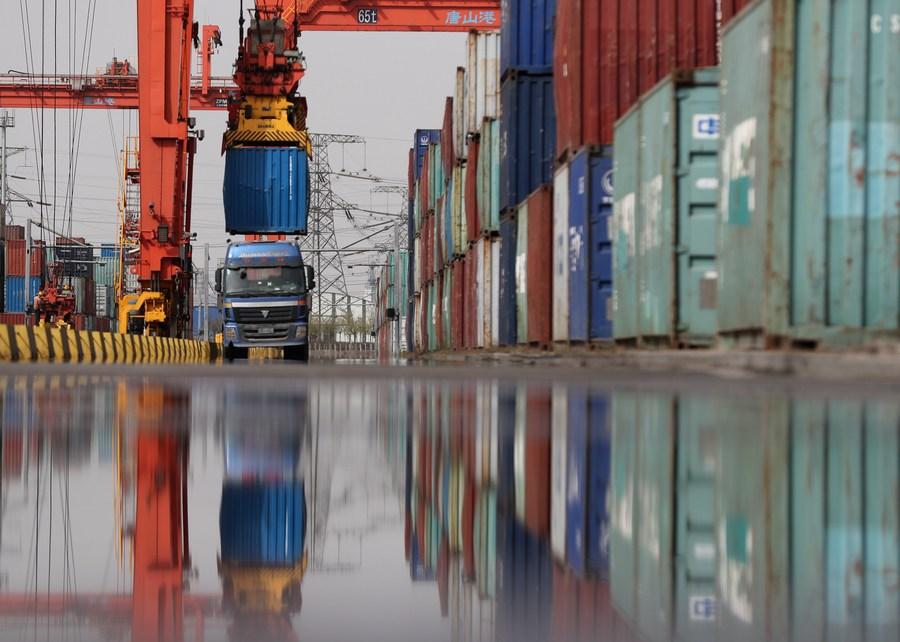
 0 Comment(s)
0 Comment(s) Print
Print E-mail China Daily, April 10, 2024
E-mail China Daily, April 10, 2024

A truck loads containers at Tangshan Port, North China's Hebei province. [Photo/Xinhua]
China saw a substantial rise in exports of shipping containers in the first two months, driven by heightened security concerns in the Red Sea maritime passage and considerable growth in shipping capacity prompted by the arrival of new vessels, said container manufacturers and freight forwarders.
Exports of newly made containers at Ningbo-Zhoushan Port in East China's Zhejiang province amounted to 831 million yuan ($115 million) in the first two months, soaring nearly 400 percent year-on-year, while Foshan, another shipping container manufacturing hub in South China's Guangdong province, saw the export of containers exceed 40,000 twenty-foot equivalent units (TEUs) during the period, jumping 460 percent, statistics from Ningbo and Guangzhou Customs showed.
Containers are the chief form of conveyance for the long-distance seaborne transport of goods. Over 90 percent of the world's containers are produced in China, said the Beijing-based China Container Industry Association.
Zhang Zhuohui, assistant president of Ningbo Xinhuachang International Containers Co Ltd, said that after the explosive growth of the market in 2021, there was a short-term surplus of containers, leading to a relatively sluggish order situation in 2023. Since the beginning of this year, demand has been recovering.
China's container export volume amounted to 2.31 million units in 2023, down 27.9 percent year-on-year. The latest data showed that in January and February of this year, the country's container export volume reached 640,000 units, surging 114.7 percent on a yearly basis, said a report by the Shenzhen Zhongshang Industry Research Institute Co Ltd, an industry consulting service provider based in Shenzhen, Guangdong province.
"We are hiring workers on a daily basis to meet surging overseas demand," said Zhang, adding that the ongoing tensions in the Red Sea region have escalated the risks for shipping companies transporting goods through one of the busiest shipping lanes in the world, leading to a spike in rates and resulting in a shortage of available shipping containers in ports of many countries.
In addition to arranging ships to carry newly made containers to ports in North America and Europe, shipping companies such as Switzerland-based Mediterranean Shipping Co SA and France's CMA CGM have deployed ships specifically to load newly made containers and supply them to overseas ports, said Yu Shuai, assistant manager of the shipping department at Ningbo Huagang International Shipping Agency Co Ltd.
Since last year, a large number of container ships have been delivered across the world, creating more demand for containers. At the same time, the Red Sea tensions have affected parts of the supply chain, causing a temporary structural shortage of containers, said Yu.
Moreover, new containers are increasingly being exported along with goods. China's total export value reached 3.75 trillion yuan in the first two months, a year-on-year increase of 10.3 percent. The country's growing trade volume has also boosted demand for containers.
"Empty containers at our terminals stood at 158,000 TEUs at the peak period in February. The number has dropped to 80,000 TEUs in late March," said Wu Guangji, deputy manager at the operation unit of Ningbo Beilun Third Container Terminal Co Ltd.
Zhou Zhicheng, director of the research department at the Beijing-based China Federation of Logistics and Purchasing, said that the ongoing tensions in the Red Sea are likely to lead to increased costs across the global supply chain in the second half.
This situation has resulted in rising expenses related to international transportation, overseas warehousing and management of supply chains. It has also amplified other risks through knock-on effects, said Zhou.
Go to Forum >>0 Comment(s)